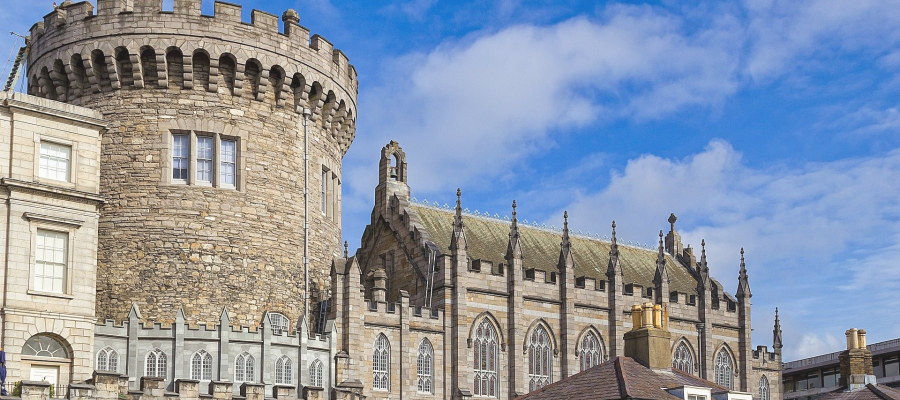
Dublin is the first and only city where I had to try four times to come to this city. Due to the previous three misfortune where I didn’t buy the ticket while thinking I did it, forfeited the flight due to work and forgot the boarding pass at the gate; I almost decided against going to Dublin the fourth time. I felt that there must be some intervention from an external force.
I had this fascination with Dublin years before I traveled to Europe for the first time. It all started in my college English class when we had to read James Joyce book “Dubliners.” Ever since reading the book, a rather depressing book about poor people working and living a sad life, I’d imaged what I would do when I come to Dublin, which I thought would be totally depressing. I would follow the River Liffey and visualize the characters and scenes in the book to get a glimpse of what life would have been like in those days.
I set myself up for a huge ‘disappointment’ when I finally arrived in Dublin. The city was nothing like I imagined, dull, depressing and full of people who were bored with life. What was I thinking? I came to Dublin of 2009 with a theorized picture of Dublin during World War I when the book was first published.
Dublin was full of life. I didn’t have a dull moment. I had a constant giddiness I couldn’t explain why. Maybe this was the first time in 3 years that I was in an English-speaking country where I could finally stick my nose in all the conversations going all around me. Or maybe it’s just the lively character of the Irish people.
I highly recommend Sandemans‘ New Dublin free walking tour. My guide was a History major, hilarious and knowledgeable about the history of Dublin and Ireland. He told many odd and obscure events I wouldn’t have known just by reading guidebooks. These Sandemans guides work strictly on tips, so although you are not required to pay them anything, you should tip them.
The 3-hour tour starts at 11 a.m. and 1 p.m. and in front of the City Hall. The tour covers major tourist attractions of Dublin like the castle, medieval wall, Viking remains, Christ Church Cathedral, Trinity College, Temple Bar to name a few. You’ll learn a great deal about the history of Dublin and Ireland through stories about their Viking history, events leading up to the 1914 Easter Rising, the social tension between rich English rulers and poor Irish subjects at the time writer Jonathan Swift wrote his famous satire “The Modest Proposal” and much more.
The guide on my tour acted out his interpretation of historical events, making it easier to visualize the scenes. When he was describing a scene from the Easter Rising in front of a castle, an Irish bystander objected this interpretation, argued and took out a history book to tell his version of the event.
I met Chunghwa, a solo female tourist, at the tour and traveled with her for the rest of the day. We wanted to join the evening pub crawl tour operated by the Sandemans but decided against it after learning that Guinness wasn’t included in the free beers offer. For €10, we could drink a few Guinness in a couple of bars. She and I ‘kidnapped’ another solo female tourist from Japan while walking around Temple Bar and convinced this woman to join our self-guided pub crawl. Not sure which bar to choose, we walked into a place call “Temple Bar” and had a round of Guinness before heading on to Oliver St. John Gogartys, a lively Irish pub for another round of Guinness, Irish folk music performance, and tap dance.
There isn’t a real typical Irish dish because Irish people eat similar meals to other places in Europe. They eat a lot of meat and potatoes – what’s new. They usually grill pork turn them into sausages, served as teatime snacks – can you believe it? Ireland national dish, Irish stew, is somewhat similar to the Hungarian goulash but lighter and made from chicken or beef, not pork.
Another Irish specialty is tripe. In Cork, you will impress people if you order “Drisheen tripe and a Guinness on the side please,” but don’t bother to find out what “drisheen” means because you wouldn’t want to eat it. Ok, I’ll spoil your fun. Drisheen is a type of black blood pudding made from the blood of cows, sheep or pigs; mixed with salt, milk, fat and breadcrumbs; and finally wrapped in pig or sheep intestine. How does that sound for a lovely breakfast?
You might assume that Irish people consume lots of fish; they don’t. Fish isn’t expensive and cost roughly the same as meat. The most popular fish are salmons. An Irish breakfast is an English breakfast with the name changed and minus the blood pudding. You’ll have fried sunny-side-up eggs, sausages, bacon and black or white pudding. If you skipped my previous paragraph, make sure you know that Irish pudding is not the kind of sweet stuff you feed to babies and sick patients in the hospitals. Both types of pudding are made to look like sausages. White pudding lack pudding is made from pork meat, bread and oatmeal. Black pudding is basically congealed pig blood.
Irish people eat lots of sweet for desserts. Some examples are bread and butter pudding (now the civilized pudding), apple tart and cream and Rhubarb crumble cakes.
Beer is commonly associated with the Irish people – think of the Irish stereotype. There are three types of beer brewed in Ireland: stout, larger and ale. While stout is better known to foreigners thanks to the famous Guinness, lager is the favorite for local people.
Accommodation
Food
[slickr-flickr type=”galleria” tag=”dublin” caption=”on” descriptions=”on”]